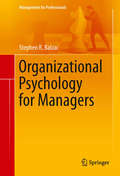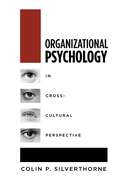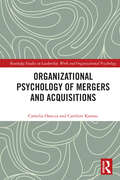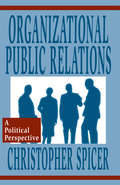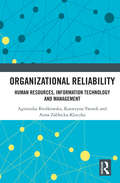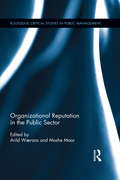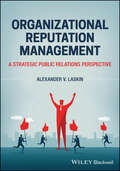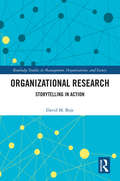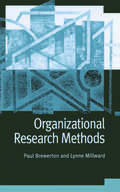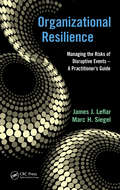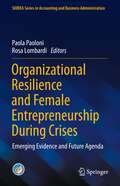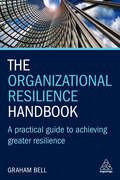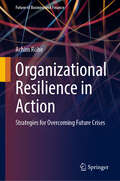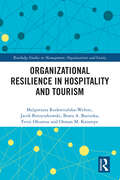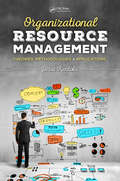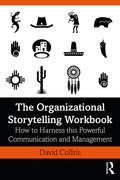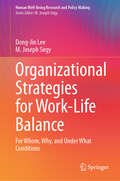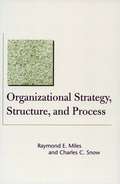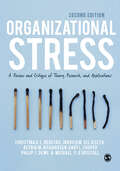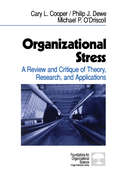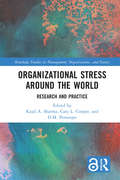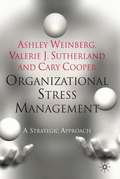- Table View
- List View
Organizational Psychology for Managers
by Stephen R. BalzacNo matter how monolithic it may appear, an organization is a collection of moving parts. Whether we are looking at building teams, providing leadership, hiring and training employees, problem solving, managing time effectively, or setting aggressive, inspiring goals, every decision can easily impact every other decision. The complexity can quickly become overwhelming. Organizational Psychology identifies a framework and offers key methodologies managers need to define behavioral tendencies and navigate complex organizational systems. Each chapter takes a high-level view of a particular aspect of organizational psychology, focusing on elements that shape companies and drive operational efficiency. Senior-level managers and C-Suite executives will benefit from the strategies presented in this book as they clearly indicate how to understand and leverage the psychological underpinnings of any corporate environment. Balzac combines stories of jujitsu, wheat, gorillas, and the Lord of the Rings with very practical advice and hands-on exercises aimed at anyone who cares about management, leadership, and culture. Todd Raphael Editor-in-Chief ERE Media Riveting! Yes, I called a leadership book riveting. I couldn't wait to finish one chapter so I could begin reading the next. The book's combination of pop culture references, personal stories, and thought providing insights to illustrate world class leadership principles makes it a must read for business professionals at all management levels. Eric Bloom President Manager Mechanics, LLC Nationally Syndicated Columnist and Author Organizational Psychology for Managers is an insightful book that reminds the business leader of basic principles of leading a successful organization in an engaging style. As a business owner for over 25 years, I am aware of these principles; however, I need reminding of how these principles work together and impact the energy and success of my company. Throughout the book, the author demonstrates these concepts into a clear perspective by citing examples within other companies which is always a helpful technique and is often eye opening . These are situations that I may not have thought about before. This book holds the reader's interest from start to finish. I look forward to his next book! Elizabeth Brown President Softeach, Inc. "Author Stephen Balzac has written a terrific book that gets into the realpolitik of organizational psychology - the underlying patterns of behavior that create the all important company culture. He doesn't stop at the surface level, explaining things we already know like 'culture beats strategy' - he gets into the deeper drivers and ties everything back to specific, actionable stories. For example he describes different approaches to apparent "insubordination" by a manager; rather then judging them, he shows how each management response is interpreted, and how it then drives response. Balzac preaches real engagement with one's own company and a mindful state of operation, especially by executives - who must remember that culture "just happens" unless and until they learn to recognize that their behaviors play a huge part in creating and cementing it. It covers the full spectrum of corporate life, from challenging bad decisions to hiring, training, motivating teams - and the secrets of keeping people engaged and learning - and/or avoiding actions which do the opposite. I highly recommend this book for anyone who wants to participate in creating and steering company culture." Sid Probstein Chief Technology Officer Attivio - Active Intelligence I had the privilege of meeting Stephen Balzac at the 2011 International Computer Measurement Group (CMG) Conference. He was one of our keynote speakers at the Conference that year. His presentation was amazing. It was the first presentation I had seen at our Conference in which the speaker not only gave a non-technical presentation that left the audience captivated and hungry for more, but he did it without using PowerPoint, or other visuals and simply with the streng...
Organizational Psychology in Cross Cultural Perspective
by Colin P. SilverthorneThe last two decades have seen an explosive increase in the ethnic diversity of the workforce, growth in international business, and the emergence of many more multinational companies.The potential for problems as companies operate across borders and managers manage in countries which have different values, norms and cultural behaviors is great. By looking at organizational psychology in a cross-cultural context, we can gain an understanding of the challenges facing organizations and business today.This text breaks new ground in introducing organizational psychology from a cross cultural perspective. It provides a foundational overview of the current major theories in organizational psychology, and illuminates the impact of cultural differences on organizational dynamics. It also makes available specific research concerning our current understandings of how these dynamics play out in particular regions and countries, such as autocratic versus democratic leadership styles in Africa and Europe or conflict management in Asia. The volume offers a welcome introduction to the topic to those in industrial/organizational psychology, international relations and management, and international business/MBA programs focusing on international issues.
Organizational Psychology of Mergers and Acquisitions: Examining Leadership and Employee Perspectives (Routledge Studies in Leadership, Work and Organizational Psychology)
by Caroline Kamau Camelia OanceaOrganizational Psychology of Mergers and Acquisitions provides a comprehensive perspective that helps you understand, empathise and protect the wellbeing of employees who experience mergers and acquisitions. This book gives a state-of-the-art review that crosses different subjects within psychology including psychobiology, neuroscience, social psychology, interpersonal relationships, and organizational psychology. This book discusses why many employees think of mergers or acquisitions as scary or threatening events, why negative emotions are prevalent, their psychobiological impact and how to assess employees’ emotional responses using a new toolkit. It helps readers learn what counts as good leadership, considering the role of charisma, personality, context and information processing abilities. This book includes the issue of organizational learning, and the relevance of occupational health and safety to due diligence about mergers and acquisitions through case studies about organizations sued for cancer or cancer-related mortality after a merger or acquisition. This book is mandatory reading for students, academics, and practitioners working with organizations experiencing a merger or an acquisition such as consultants, human resource professionals, psychologists, occupational health professionals, and employees involved in strategy, management, or people development.
Organizational Public Relations: A Political Perspective (Routledge Communication Series)
by Christopher SpicerPublic relations practitioners are often called upon to help chart their organization's strategic development, thus functioning as managerial decision makers linking the organization to its larger environment. This book is about understanding organizations, especially the role played by organizational decision making in the development and implementation of public relations programs and activities. It emphasizes the ways in which an organization's culture and decision making processes ultimately influence the success or failure of their public relations efforts. The research, case studies, and author's interpretations and suggestions explore the often confusing netherworld of organizational mindsets -- particularly as those world views affect the organization's relations with clients and other stakeholders. Understanding organizational politics is the way to understanding how and why decisions are made by the organization's dominant coalition. The primary goal of this text is to enhance our understanding of the ways in which organizations "work" -- the political process that accompanies organizational decision making. As an instrumental participant in the organizational political process, the public relations practitioner must posess knowledge and understanding of the organization's political process in order to succeed within that organization. Given the need for public relations practitioners to form coalitions, negotiate consensus, and advocate organizational interests, the political system metaphor is most approriate for understanding the relationship between organizational power and organizational public relations. This book, then, "steps back" from a focus solely on the design of public relations programs, and instead examines how the impetus for those programs emerges within the organization as a result of organizational politics in action. Its special features include: * practitioner responses at the end of each chapter providing commentary on the usefulness of the ideas presented; * sidebars from popular sources illustrating theories; * new case studies; * merging of management and organizational theory and research with communication theory and research; * a focus on external stakeholders from both an advocacy and a collaborative frame resulting in the creation of a "collaborative advocacy" framework for external communication; and * an extended examination of ethical considerations pertaining to organizational decision making and communication.
Organizational Reinvention
by Ryan L. RaffaelliThis note is designed to introduce students to the fundamental concepts of leading innovation in established organizations. Reinvention is a process whereby organizations respond to changes in the environment that threaten their core business model, technologies, cultural values, and/or operational norms. Reinvention represents a managerial paradox for organizations that have experienced several years of success: leaders must preserve some elements of the business that once made it successful and simultaneously change other elements that, if left unattended, could render the organization obsolete. The Note outlines four elements associated with organizational reinvention: 1) Understanding technology lifecycles and s-curves: What are technology lifecycles and s-curves?; 2) Reinvention by extending existing capabilities: How do leaders extend existing organizational capabilities in response to new technologies?; 3) Reinvention by adopting new capabilities: How do leaders adopt new capabilities in response to new technologies?; 4) Readying your organization for reinvention: How do leaders develop the right mindset and the right team to engage in a reinvention effort? Finally, the Note includes several diagnostic tools that students and executives can use to analyze an organization's readiness for reinvention.
Organizational Reliability: Human Resources, Information Technology and Management (Routledge Studies in Management, Organizations and Society)
by Katarzyna Tworek Agnieszka Bieńkowska Anna Zabłocka-KluczkaThis book explores the identified research gap and new field of study of organizational reliability. It develops a definition and theoretical internal structure of the notion of organizational reliability as well as a theoretical background describing the structure of its three pillars, and it showcases a set of organizational solutions dedicated for the enhancement of organizational reliability. The book explores the idea that there are new capabilities needed in every organization: reliability capabilities aiming at enhancing and sustaining the reliability of entire organizations and reliability of management, information technology and human resources. The reliability capabilities are understood as the abilities to anticipate and explore potential and occurring hazards, prevent and resolve disruptions, and learn from the problems in order to maintain a proper organizational performance in both normal and abnormal situations. Based on these three pillars, the book concerns the issue of various organizational solutions in order to indicate a set of them, which supports obtaining and maintaining organizational reliability. The book is recommended reading for researchers, academics and students in the fields of management, and entrepreneurs trying to boost the reliability of their organizations.
Organizational Reputation in the Public Sector: Branding, Identity, And Images Of Government (Routledge Critical Studies in Public Management)
by Moshe Maor Arild WæraasA favorable reputation is an asset of importance that no public sector entity can afford to neglect because it gives power, autonomy, and access to critical resources. However, reputations must be built, maintained, and protected. As a result, public sector organizations in most OECD countries have increased their capacity for managing reputation. This edited volume seeks to describe, explain, and critically analyze the significance of organizational reputation and reputation management activities in the public sector. This book provides a comprehensive first look at how reputation management and branding efforts in public organizations play out, focusing on public agencies as formal organizations with their own hierarchies, identities, and cultures – existing in a network of other public organizations with similar or different functions, power, and reputation. From this unique organizational perspective, the chapters in this volume examine issues such as organizational identity, power, conflict, politics, culture, and symbolism within the public sector. Paying specific attention to strategies and processes, and illustrating with examples from the countries of Belgium, Denmark, Norway, Ireland, Israel, Italy, and Sweden, the book deepens our understanding of reputation management efforts at various levels of government.
Organizational Reputation Management: A Strategic Public Relations Perspective
by Alexander V. LaskinORGANIZATIONAL REPUTATION MANAGEMENT Teaches public relations through the management of relationships with key organizational publics, perfect for business and management students Organizational Reputation Management: A Strategic Public Relations Perspective presents comprehensive coverage of how corporations, governments, and non profit organizations build and maintain their reputation. This unique textbook provides students with a solid understanding of the function of public relations as a strategic activity, as author Alexander V. Laskin offers a real-world relationship management perspective while employing an innovative approach to defining and analyzing reputation. Student-friendly chapters introduce all essential concepts of reputation management, describe the entire process of reputation management, help future organizational leaders appreciate the importance of reputation, explain measurement and evaluation methods, and define organizational reputation through relationships with key stakeholders such as investors, employees, and customers. Designed to be used with the PRSA MBA/Business School Initiative curriculum, Organizational Reputation Management demonstrates how to apply the Research, Planning, Implementation, and Evaluation (RPIE) process, the Paid, Earned, Shared, and Owned (PESO) communications model, the Barcelona Principles, and other key public relations concepts in the context of organizational reputation. Organizational Reputation Management: A Strategic Public Relations Perspective is the ideal textbook for undergraduate and graduate courses in reputation management, public relations management, and strategic communication.
Organizational Research: Storytelling in Action (Routledge Studies in Management, Organizations and Society)
by David M. Boje‘Organizational research methods’ (ORM) are making an ontological turn by studying the nature of Being, becoming, and the meaning of existence in the world. For example, without ontology, there is no ‘ground’ and no ‘theory’ in Grounded Theory (GT). This book explores ten ways to develop fourth wave GT that is grounded and theory. 1st wave GT commits inductive fallacy inference, 2nd wave GT bandaids it with positivistic content coding. 3rd wave GT turns to social constructivism, but this leaves out the materiality and ecology of existence. The first three waves do not address falsification or verification. There is another theme. Qualitative research methods is a discipline craft, not mere science or something that automated text analysis software can displace. Quantiative narrative analysis (QDA) is one more way to colonize and marginalize indigenous ways of knowing (IWOK). Without an ontological turn, its the death of storytelling predicted by Walter Benjamin and Gertrude Stein predicted. The good news is Western Empirical Science is beginning to listen to IWOK-Native Science experiential living story method of relations not only to other humans but to other animals, plants, to living air, water, and earth in living ecosystem of an enchanted world There is a gap in the qualitative research methodology practices and comprehensive advanced approaches causing a split between practice and theory. So called Grounded Theory (inductive positivism) . Organizational Research: Storytelling in Action is about how to conduct ten kinds of ontological Research Methods and conduct their interpretative analyses, for organization studies, in an ethically answerable way. It is aimed at people who want a more ‘advanced’ treatment than available in so-called Grounded Theory or automated narrative analysis books.
Organizational Research Methods: A Guide for Students and Researchers
by Lynne Millward Paul M Brewerton`This text provides a timely and comprehensive introduction to major research methods in the Organizational sciences. It will be a boon to all students conducting their projects in this area, and may well become a standard reference for staff teaching research methods to undergraduate and postgraduate students of business studies or organizational behaviour' - Professor Neil Anderson, Goldsmiths College, University of London 'This reasonably priced text would provide an invaluable starting point for those considering undertaking research in organisational settings' - Paula Roberts, Nurse Researcher This book provides the reader with clear pointers for how to conduct organizational research appropriately, through planning and making informed and systematic research decisions, to understanding the ethical implications of applied organizational research, to implementing, reporting and presenting the findings to the highest possible standards. It provides an overview of a wide variety of research strategies, methods of data collection (both qualitative and quantitative) and analysis in a volume accessible to both an undergraduate, postgraduate and practitioner readership alike. Organizational Research Methods also represents a useful aid to the report writing task, indicating ways in which the project material can be most effectively organised for academic and feedback purposes, and by drawing upon real-life organizational contexts and examples to help the reader understand the core issues. Finally, the book offers a clear, manageable procedure for preparing a presentation to an academic or an organizational audience. Providing practical guidance on all elements of the research process, this book will be essential reading to all undergraduate and postgraduate students, as well as researchers, in psychology, organizational studies and management disciplines.
Organizational Resilience: Managing the Risks of Disruptive Events - A Practitioner's Guide
by Marc H. Siegel James J. LeflarMoving towards resiliency is more than just implanting policy and procedure; it is a process that takes organizations on a winding path requiring patience and tolerance. A good deal of learning will have to take place during the trip and that is why it is necessary to have patience and tolerate the learning process. Organizational Resilience: Manag
Organizational Resilience and Female Entrepreneurship During Crises: Emerging Evidence and Future Agenda (SIDREA Series in Accounting and Business Administration)
by Paola Paoloni Rosa LombardiThe economic, health, and political crises, as well as the rise of the digital age, have changed and complicated the way in which people, companies, and regions function. The goal is not just survival, but also to innovate and organize themselves to chart new paths for growth and development. This book uses this premise to understand how organizations, in particular female-led businesses, work on their resilience using specific activities and relational capital as a driver of strategic value. The chapters include theoretical as well as practical contributions about how female-owned and female-run companies and organizations can take advantage of such opportunities, in terms of challenges, issues, tools, facilitators, and mechanisms that can support the use of the new opportunities in the near future.
The Organizational Resilience Handbook: A Practical Guide to Achieving Greater Resilience
by Graham BellFor businesses to grow and be successful their approach to resilience must be defined by a holistic and risk-focused outlook, rather than one which is narrow and dominated by event-oriented continuity practices. The Organizational Resilience Handbook shows that success is as much to do with innovation and the speed with which new products are brought to market as it is with organizations having to deal with unexpected crisis situations. It comprehensively covers the full breadth and depth of the field and introduces related topics such as security, safety, e-commerce, emerging technologies and customer experience.Through adopting a strategic and progressive approach, practitioners can apply the book's methodology to develop an in-depth understanding of resilience within their own organization and use it to effectively engage with the board and senior management in developing strategies for achieving greater resilience capability. A range of high-profile case studies, such as Mercedes, the UK's National Health Service, Alibaba and BP, help to illustrate the concept of resilience by detailing characteristics and behaviours which confirm its meaning. The Organizational Resilience Handbook is a practical guide to self-assessment, benchmarking performance and implementing resilience frameworks in any organization.
Organizational Resilience in Action: Strategies for Overcoming Future Crises (Future of Business and Finance)
by Achim RöheIn a rapidly evolving digital landscape, companies are increasingly driven by automation, where software algorithms replace human decision-making. This book explores the concept of the self-driving company, an organization that has reached a high level of automation through various stages of development. It tackles the critical question: Can we trust such automated entities? Using intuitive models and clear, practical examples, the book demonstrates how these future companies can develop resilience and effectively handle upcoming crises. It provides insights into how businesses can adapt and thrive in a volatile, uncertain, complex, and ambiguous (VUCA) world, making it essential reading for those interested in the future of digitalization and resilience management.
Organizational Resilience in Hospitality and Tourism (Routledge Studies in Management, Organizations and Society)
by Malgorzata Rozkwitalska-Welenc Jacek Borzyszkowski Beata A. Basinska Fevzi Okumus Osman M. KaratepeAlthough ‘VUCA’ is not a new term, the features of the world it describes, a volatile, uncertain, complex and ambiguous environment, have never been more valid. The VUCA world has become the new reality for business, specifically for hospitality and tourism organizations that are more vulnerable than any other sector due to the historically-recognized turbulent environment in which they operate. In this book, the authors present unique factors that make hospitality and tourism organizations resilient in the VUCA world. With contacts at the center of their hospitality and tourism organizational resilience model, the organizational and psychological perspectives are also incorporated. This innovative volume tests the model of organizational resilience in hospitality and tourism organizations. The study identifies and validates organizational and individual factors that create a resilient organization in the hospitality and tourism sector. It will be of interest to researchers, academics, practitioners, and advanced students in the fields of organizational studies, strategic management, hospitality, and tourism management.
Organizational Resource Management: Theories, Methodologies, and Applications
by Jussi KantolaThe management of organizational resources is extremely difficult. Managers face serious and complex challenges when managing the required resources for the benefit of their organization. This book presents a unique approach that aims to tackle these management challenges. This approach is based on four propositions that together form a solid frame
The Organizational Storytelling Workbook: How to Harness this Powerful Communication and Management Tool
by David CollinsThis workbook is an interactive guide for leaders and managers to help you tell compelling stories at work. The Organizational Storytelling Workbook offers: a critical engagement with academic debates on organizational storytelling; and a series of exercises designed to allow users to improve their capability as organizational storytellers. The text begins with a chapter which locates organizational storytelling within a critical account of organizational cultures. This book argues that managerial accounts of organizational culture offer a limited appreciation of the ways in which people think, feel and act and suggests storytelling as a means of redeeming our understanding of all matters cultural. Having secured this new appreciation of culture and storytelling the workbook develops a series of maxims and exercises designed to allow users: (a) to improve their storytelling practice; and (b) to reassess the cultural assumptions and priorities revealed through their practice. Enriched with interactive features to walk managers practically through the process of improving their storytelling skills, including practical exercises, contemplative questions, and space to respond creatively to the ideas in the book, this workbook is the perfect companion to any executive or postgraduate course in storytelling as well as a useful and enjoyable companion to any individual manager that wishes to improve their skills.
Organizational Strategies and Business Models: Better Biotechnology
by Gary P. PisanoThe scientific and commercial promise of biotechnology has been impeded by the way the business is structured and operated. What are the key strategic issues facing younger and more established biotechnology firms, specifically on questions of vertical integration and organizational boundaries? This chapter focuses on the strategies and business models biotech and established pharmaceutical companies might deploy to improve their performance and realize the industry potential to transform health care. This chapter is excerpted from "Science Business: The Promise, the Reality, and the Future of Biotech."
Organizational Strategies for Work-Life Balance: For Whom, Why, and Under What Conditions (Human Well-Being Research and Policy Making)
by M. Joseph Sirgy Dong-Jin LeeThis book provides a systematic review of the research literature related to the effectiveness of organizational policies and programs on work-life balance (WLB). It discusses policies and practices related to workload management, flextime, flexplace, alternative job arrangements, and family care. Based on the evidence, the authors make specific recommendations to organizational executives and HR directors to design and implement work-life balance policies and programs to maximize their effectiveness and help employees achieve their optimal level of work-life balance. Specifically, the authors discuss how to: (1) identify employees with greater need for WLB programs, (2) evaluate environmental circumstances for WLB programs (3) design effective WLB policies and programs, (3) facilitate effective implementation of WLB policies and programs, (4) provide management support for WLB policies and programs, and (5) evaluate performance of WLB policies and programs. Written lucidly by experts in the field and with many case studies and examples, this book appeals to a wide range of academic and professional readers.
Organizational Strategy, Structure, and Process (Stanford Business Classics)
by Raymond E. Miles Charles C. Snow"Books and articles come and go, endlessly. But a few do stick, and this book is such a one. Organizational Strategy, Structure, and Process broke fresh ground in the understanding of strategy at a time when thinking about strategy was still in its early days, and it has not been displaced since." —David J. Hickson, Emeritus Professor of International Management & Organization, University of Bradford School of Management Originally published in 1978, Organizational Strategy, Structure, and Process became an instant classic, as it bridged the formerly separate fields of strategic management and organizational behavior. In this Stanford Business Classics reissue, noted strategy scholar Donald Hambrick provides a new introduction that describes the book's contribution to the field of organization studies. Miles and Snow also contribute new introductory material to update the book's central concepts and themes. Organizational Strategy, Structure, and Process focuses on how organizations adapt to their environments. The book introduced a theoretical framework composed of a dynamic adaptive cycle and an empirically based strategy typology showing four different types of adaptation. This framework helped to define subsequent research by other scholars on important topics such as configurational analysis, organizational fit, strategic human resource management, and multi-firm network organizations.
Organizational Stress: A Review and Critique of Theory, Research, and Applications
by Cary L. Cooper Philip J. Dewe Christina G. Nerstad Ingvild M. Seljeseth Astrid M Richardsen Michael P O′DriscollWhat price do organizations and nations pay for a poor fit between employees and their work environments? Negative stress imposes a high cost on individual health and well-being as well as organizational health and productivity. This comprehensive textbook examines the definitions of job-related stress and the methods used to assess levels and consequences of occupational stress, along with strategies that may be used by individuals and organizations to confront negative stress and its associated problems. From sources of stress to organizational interventions, and from job-related burnout to coping with stress, Organizational Stress gives the reader – whether researcher, student, or practitioner – a basis for tailoring work environments which contribute to the health and well-being of individuals, organizations, and even the societies in which they live. This new edition has been updated to reflect the most relevant research in the field of organisational stress, including a completely new chapter on stress and the brain. It also focusses on the future of work in our rapidly changing world – dealing with contemporary contexts such as the COVID-19 pandemic and the rise of the gig economy. Christina G.L. Nerstad is a Professor at BI Norwegian Business School Ingvild M. Seljeseth is an Associate Professor at Kristiania University College Astrid M. Richardsen is Professor Emerita at BI Norwegian Business School Cary L Cooper is a Professor at Alliance Manchester Business School Philip J. Dewe is Emeritus Professor at Birkbeck, University of London Michael P. O′Driscoll is Emeritus Professor at University of Waikato
Organizational Stress: A Review and Critique of Theory, Research, and Applications
by Cary L. Cooper Philip J. Dewe Christina G. Nerstad Ingvild M. Seljeseth Astrid M Richardsen Michael P O′DriscollWhat price do organizations and nations pay for a poor fit between employees and their work environments? Negative stress imposes a high cost on individual health and well-being as well as organizational health and productivity. This comprehensive textbook examines the definitions of job-related stress and the methods used to assess levels and consequences of occupational stress, along with strategies that may be used by individuals and organizations to confront negative stress and its associated problems. From sources of stress to organizational interventions, and from job-related burnout to coping with stress, Organizational Stress gives the reader – whether researcher, student, or practitioner – a basis for tailoring work environments which contribute to the health and well-being of individuals, organizations, and even the societies in which they live. This new edition has been updated to reflect the most relevant research in the field of organisational stress, including a completely new chapter on stress and the brain. It also focusses on the future of work in our rapidly changing world – dealing with contemporary contexts such as the COVID-19 pandemic and the rise of the gig economy. Christina G.L. Nerstad is a Professor at BI Norwegian Business School Ingvild M. Seljeseth is an Associate Professor at Kristiania University College Astrid M. Richardsen is Professor Emerita at BI Norwegian Business School Cary L Cooper is a Professor at Alliance Manchester Business School Philip J. Dewe is Emeritus Professor at Birkbeck, University of London Michael P. O′Driscoll is Emeritus Professor at University of Waikato
Organizational Stress: A Review and Critique of Theory, Research, and Applications
by Dr Cary P. Cooper Dr Philip J. Dewe Dr Michael P O'DriscollThis book examines stress in organizational contexts. The authors review the sources and outcomes of job-related stress, the methods used to assess levels and consequences of occupational stress, along with the strategies that might be used by individuals and organizations to confront stress and its associated problems. One chapter is devoted to examining an extreme form of occupational stress--burnout, which has been found to have severe consequences for individuals and their organizations. The book closes with a discussion of scenarios for jobs and work in the new millennium, and the potential sources of stress that these scenarios may generate.
Organizational Stress Around the World: Research and Practice (Routledge Studies in Management, Organizations and Society)
by Cary L. Cooper Kajal A. Sharma D. M. PestonjeeStress is defined as a feeling experienced when a person perceives that demands exceed the personal and social resources the individual is able to mobilize. It can occur due to environmental issues, such as a looming work deadline, or psychological, for example, persistent worry about familial problems. While the acute response to life-threatening circumstances can be life-saving, research reveals that the body’s stress response is largely similar when it reacts to less threatening but chronically present stressors such as work overload, deadline pressures and family conflicts. It is proffered that chronic activation of stress response in the body can lead to several pathological changes such as elevated blood pressure, clogging of blood vessels, anxiety, depression, and addiction. Organizational Stress Around the World: Research and Practice aims to present a sound theoretical and empirical basis for understanding the evolving and changing nature of stress in contemporary organizations. It presents research that expands theory and practice by addressing real-world issues, across cultures and by providing multiple perspectives on organizational stress and research relevant to different occupational settings and cultures. Personal, occupational, organizational, and societal issues relevant to stress identification along with management techniques/approach to confront stress and its associated problems at individual and organizational level are also explored. It will be of value to researchers, academics, practitioners, and students interested in stress management research.
Organizational Stress Management
by Ashley Weinberg Valerie J. Sutherland Cary CooperIncluding practical advice on how to conduct a stress audit and how to target stress 'hot spots' within an organization, Organizational Stress Management provides a fresh strategic model for the manager concerned with the negative effects stress can have both on company performance and the quality of life of individuals at work.
